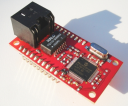Differences
This shows you the differences between two versions of the page.
| Both sides previous revision Previous revision Next revision | Previous revision Last revision Both sides next revision | ||
|
en:netzer:io [2014/08/17 16:45] svesch [Input capture (since version 1.6)] Overflow condition added |
en:netzer:io [2014/09/28 09:28] svesch [Input capture (since version 1.6)] |
||
|---|---|---|---|
| Line 161: | Line 161: | ||
| Analogous to PWM a pulsed current is generated at the pin. It is always triggered whenever an internal counter flows over. The time duration of the counter is (65556*pulse unit). For IO3 and SPI_INT the same internal counter is used, so that both signals are always in phase. | Analogous to PWM a pulsed current is generated at the pin. It is always triggered whenever an internal counter flows over. The time duration of the counter is (65556*pulse unit). For IO3 and SPI_INT the same internal counter is used, so that both signals are always in phase. | ||
| + | |||
| + | Read more on the [[impulse|impulse page]]. | ||
| ==== Input capture (since version 1.6) ==== | ==== Input capture (since version 1.6) ==== | ||
| Line 167: | Line 169: | ||
| The capture (second) edge can be configured as falling or rising one. | The capture (second) edge can be configured as falling or rising one. | ||
| The trigger edge depends on the common impulse mode parameter (see below). | The trigger edge depends on the common impulse mode parameter (see below). | ||
| - | |||
| - | The calibration offset shall be used to compensate interrupt latency time and clock errors. | ||
| - | The value is added to each measured value automatically. | ||
| On Netzer startup or after configuring for capture mode the measured value is set to 0. | On Netzer startup or after configuring for capture mode the measured value is set to 0. | ||



